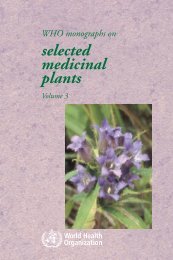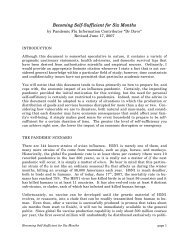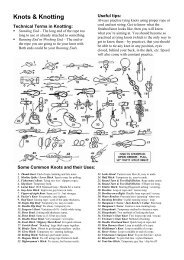Create successful ePaper yourself
Turn your PDF publications into a flip-book with our unique Google optimized e-Paper software.
COMMON EDIBLE MUSHROOMS<br />
and its scaly cap enable one to distinguish it readily from any<br />
Amanitas, and the pink gills of young specimens of Agaricus and<br />
the purple spores and gills of mature specimens permit positive<br />
identification, but species about which one is in doubt should not<br />
be eaten!<br />
Fortunately, few species of Amanita are very common outside<br />
the forested areas, but even the most deadly ones are found now<br />
and again almost wherever wild mushrooms grow.*<br />
Poisonous: AMANITA PHALLOIDES (Death Cap)<br />
This deadly species (Figure 6) has been blamed for a large<br />
proportion of the cases of fatal mushroom poisoning, since it is<br />
fairly common throughout the North Temperate Zone in America<br />
and Europe. Even a small piece is sufficient to cause serious illness<br />
or death. A clinical account of the death of four persons from<br />
amanitine poisoning is quoted in <strong>Mushrooms</strong> aiid Toadstools by<br />
Giissow and Odell, one of the references cited on page 119. A careful<br />
reading of the progress of the poisoning, through all stages<br />
from cramping pains and delirium to painful death, should serve<br />
as sufficient warning to hasty or careless mushroom hunters. It is<br />
easy enough to learn and to bear in mind the unmistakable Amanita<br />
characteristics — so easy that to ignore them is unforgivable.<br />
Several varieties of A. phalloides occur, differing chiefly in<br />
color, size, and some microscopic characters. The cap is from<br />
2 to 6 inches wide, a pale grayish brown near the center but<br />
nearly white toward the margin, convex when young and later<br />
sloping downward from the center like an inverted saucer; in old<br />
specimens the margin is raised up slightly above the rest of the<br />
cap. The surface is sticky when moist, but in dry weather it must<br />
be dampened to reveal this quality. Often on newly expanded<br />
caps, soft, white, warty patches of mycelium are scattered over<br />
the surface, but these soon disappear. The gills are white and do<br />
not touch the stem, being free as in Lepiota arid Agaricus. The<br />
* The first-aid procedure for any poison taken by mouth is to have the<br />
stomach pumped or to induce vomiting as soon as possible. Call your doctor!<br />
28
















